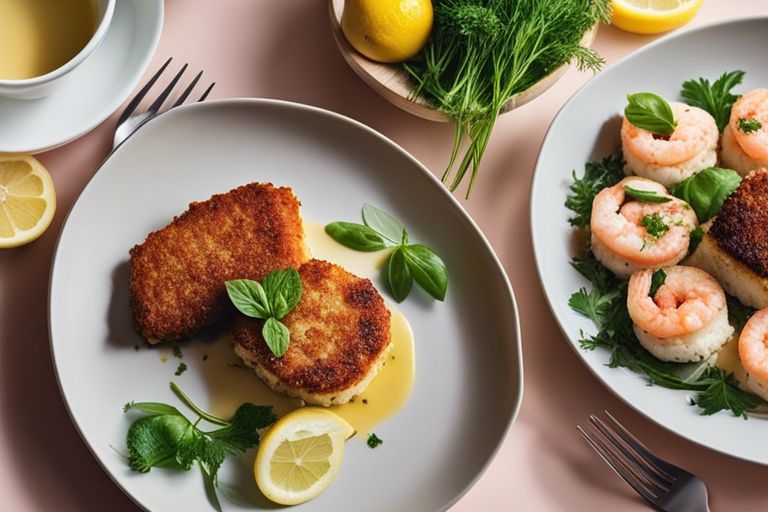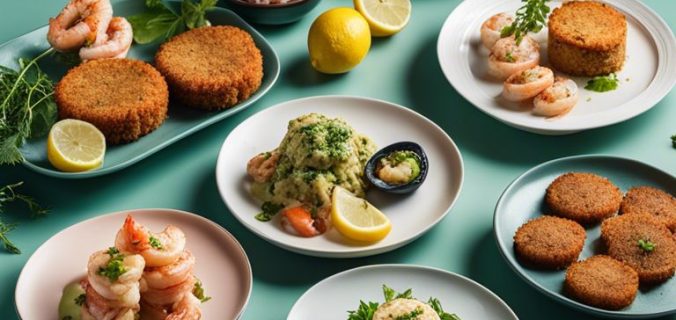Seafood lovers, rejoice! If you’re looking to enjoy the flavors of the ocean without the environmental impact or health concerns associated with traditional seafood, we’ve got you covered. These plant-based alternatives offer a delicious and sustainable way to satisfy your cravings while protecting the oceans and marine life. With innovative ingredients and culinary techniques, you can still indulge in your favorite seafood dishes without compromising on taste or texture. Let’s investigate the world of plant-based seafood and discover a whole new way to enjoy the bounties of the sea!
Key Takeaways:
- Seaweed: Seaweed is a nutritious and versatile plant-based substitute for seafood, providing a umami flavor similar to fish.
- Jackfruit: Jackfruit can be used as a meaty alternative in seafood dishes like crab cakes or fish tacos, offering a texture similar to flaky fish.
- Heart of Palm: Heart of palm is a sustainable option that can mimic the texture of scallops when marinated and cooked properly, making it a great addition to seafood recipes.
Understanding Plant-Based Seafood
What is plant-based seafood?
One of the fastest-growing trends in the plant-based food industry is the development of plant-based seafood. This innovative approach aims to recreate the taste, texture, and nutritional benefits of traditional seafood using plant-based ingredients.
The ingredients that make it possible
On the forefront of plant-based seafood products are ingredients such as algae, seaweed, konjac, and soy protein. These key ingredients are carefully selected and combined to mimic the taste and texture of popular seafood options like fish, shrimp, and crab.
Make sure to check the label of plant-based seafood products to ensure they are free from harmful additives or excessive sodium content. Despite being a healthier and more sustainable choice compared to traditional seafood, some plant-based alternatives may still contain high levels of sodium or artificial additives.
Top Plant-Based Seafood Alternatives
Plant-based fish fillets and their preparation
The plant-based seafood market is booming, offering a wide variety of fish fillet alternatives that are not only delicious and sustainable but also easy to prepare. Plant-based fish fillets made from ingredients like algae, pea protein, and seaweed can be breaded and pan-fried for a crispy texture, or baked and added to tacos for a flavorful twist. These fillets are not only high in protein and omega-3 fatty acids but are also cholesterol-free, making them a healthy choice for seafood lovers looking to reduce their carbon footprint.
Plant-based shellfish alternatives and recipes
In the context of replacing shellfish in your favorite recipes, there are a variety of plant-based alternatives that can mimic the taste and texture of shrimp, scallops, and crab. Plant-based shellfish alternatives can be made from ingredients like konjac root, heart of palm, or king oyster mushrooms, and can be used in dishes like stir-fries, pasta dishes, and seafood boils. These alternatives not only provide a cruelty-free option for seafood enthusiasts but also offer a low-calorie and fiber-rich substitute for traditional shellfish.

Incorporating Plant-Based Seafood into Your Diet
Tips for a seamless transition
Despite being a fan of seafood, transitioning to a plant-based diet may seem daunting at first. However, with the right approach and mindset, you can easily incorporate plant-based seafood into your meals. Here are some tips to help you make a seamless transition:
- Start slow: Begin by incorporating small amounts of plant-based seafood into your meals and gradually increase the quantity as you get used to the taste and texture.
- Experiment with recipes: Try out different recipes and cooking methods to find the ones that suit your taste preferences the best.
- Stock up on seasonings: Using herbs, spices, and sauces can help enhance the flavor of plant-based seafood dishes and make them more appealing.
Though it may take some time to adjust, incorporating plant-based seafood into your diet can be a rewarding experience that benefits both your health and the environment.
Creative ways to enhance flavor and texture
To elevate the taste and texture of your plant-based seafood dishes, consider experimenting with different ingredients and cooking techniques. By infusing your meals with a variety of flavors and textures, you can create a diverse and satisfying culinary experience.
Understanding the importance of seasonings and marinades is crucial in enhancing the overall taste of plant-based seafood. Ingredients such as citrus juices, soy sauce, and garlic can add depth and richness to your dishes. Additionally, incorporating herbs such as dill, parsley, and basil can provide a fresh and aromatic element to your creations. By experimenting with different combinations, you can discover unique and flavorful ways to enjoy plant-based seafood in your diet.
Comparing Plant-Based and Traditional Seafood
Many What is Vegan Shrimp: A Sustainable Seafood Alternative
| Plant-Based Seafood | Traditional Seafood |
| Lower in calories and saturated fats | May contain high levels of cholesterol |
| Rich source of plant-based protein | May expose consumers to contaminants like mercury |
| Free of harmful antibiotics and hormones | May contribute to overfishing and habitat destruction |
| Environmentally sustainable | Can have a negative impact on marine ecosystems |
Nutritional value and health impact
To make a comparison between plant-based seafood and traditional seafood, it is important to consider their nutritional value and health impact. Plant-based seafood alternatives are often lower in calories and saturated fats, making them a healthier choice. They also offer a rich source of plant-based protein without the cholesterol found in traditional seafood, providing a heart-healthy option for consumers.
Environmental considerations
Traditional seafood consumption can have significant environmental implications. Overfishing and habitat destruction are common issues associated with the consumption of traditional seafood, leading to a decline in marine ecosystems. Considerations need to be made to ensure sustainable seafood practices to avoid further damage to our oceans.
Conclusion
Now, you can satisfy your seafood cravings with these delicious and sustainable plant-based alternatives. From savory vegan crab cakes to crispy beer-battered tofu fish, there are endless options to explore. Not only are these alternatives better for the environment, but they also provide a cruelty-free and healthy way to enjoy your favorite seafood dishes. Give these recipes a try and discover a whole new world of flavorful plant-based seafood options that will leave you feeling satisfied and guilt-free.
FAQ
Q: What are plant-based alternatives for satisfying seafood cravings?
A: Plant-based alternatives for satisfying seafood cravings include products made from ingredients such as mushrooms, seaweed, jackfruit, and tofu. These products mimic the taste and texture of seafood while being completely free of animal ingredients.
Q: Are plant-based seafood alternatives healthy?
A: Plant-based seafood alternatives are generally considered to be healthier than traditional seafood options. They are usually lower in calories, saturated fat, and cholesterol, making them a good choice for those looking to reduce their intake of animal products.
Q: Where can I find plant-based seafood alternatives?
A: Plant-based seafood alternatives can be found in health food stores, specialty grocery stores, and online retailers. Some popular brands that offer these alternatives include Gardein, Sophie’s Kitchen, Good Catch, and Ocean Hugger Foods.


Pingback: Plant-Based Seafood - Healthy And Delicious Alternatives To Try - Veganism